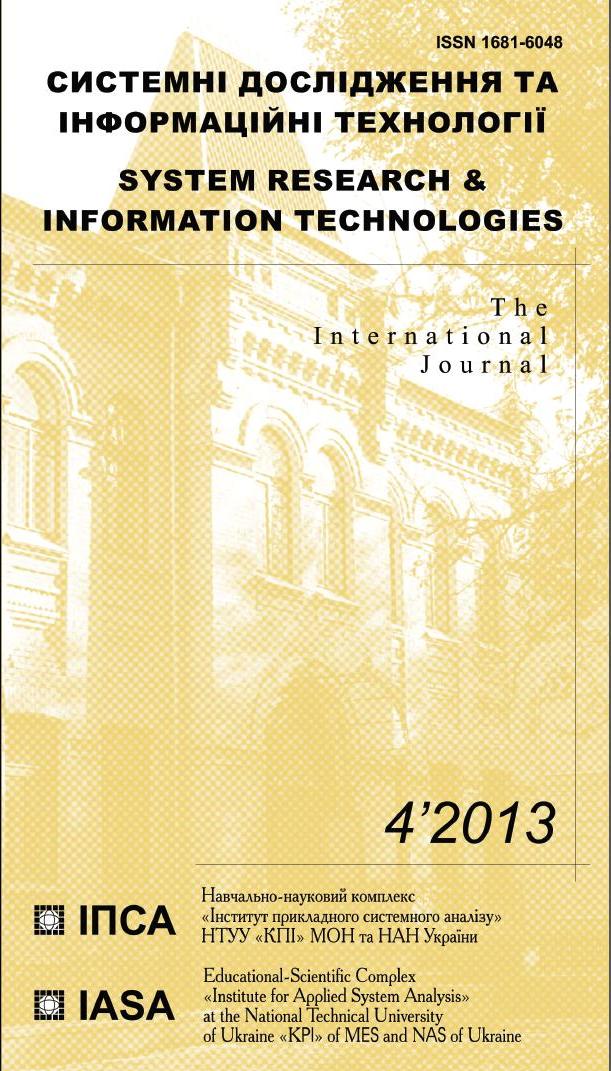Method of consistent pairwise comparisons while estimating decision alternatives by qualitative criterion
Abstract
The method, allowed to correct the inconsistency of pairwise comparison matrix, which is obtained as a result of expert evaluation of alternatives decisions on quality criteria, and get the agreed valuation depending on the properties of the pairwise comparisons matrix. The statements about multiplicative and additive adjustment of pairwise comparison matrix without expert participation are formulated and proved. Unlike well-known methods with feedback with expert, proposed method of consistency adjustment without expert participation allows cut down expenses and save time. Proposed method also includes finding and adjustment of the most inconsistent and faulty elements (outliers) without expert participation. The proposed method can be used in decision-support systems when solving problems of choice, recourse allocation, decision alternatives estimation in terms of quantitative and qualitative decision criteria, scenario estimation and also in problems of planning and technological forecasting.References
Pankratova N.D., Nedashkivs'ka N.I. Modeli i metody analizu iyerarkhiy: Teoriya. Zastosuvannya: Navchal'nyy posibnyk. — K.: IVTs "Vydavnytstvo "Politekhnika", 2010. — 371 s.
Saati T. Prinyatiye resheniy. Metod analiza iyerarkhiy. — M.: Radio i svyaz’, 1993. — 320 s.
Saati T.L. Prinyatiye resheniy pri zavisimostyakh i obratnykh svyazyakh: Аnaliticheskiye seti. Izd. 2-e. — M.: Knizhnyy dom "LIBROKOM", 2009. — 360 s.
Nogin V.D. Uproshchennyy variant metoda analiza iyerarkhiy na osnove nelineynoy svertki kriteriyev // ZHurnal vychislitel’noy matematiki i matematicheskoy fiziki. — 2004. — 44, № 7. — S. 1261–1270.
Totsenko V.G. Metody i sistemy podderzhki prinyatiya resheniy. Аlgoritmicheskiy aspekt. — K.: Naukova dumka, 2002. — 381 s.
Macharis C., Springael J., Brucker K.D., Verbeke A. PROMETHEE and AHP: The design of operational synergies in multicriteria analysis. Strenhthening PROMETHEE with ideas of AHP // European Journal of Operational Research. — 2004. — 153, № 2. — P. 307–317.
Devid G. Metod parnykh sravneniy. — M.: Statistika, 1978. — 144 s.
Larichev O.I., Moshkovich E.M. Kachestvennyye metody prinyatiya resheniy. — M.: Nauka, 1996. — 208 s.
Orlov А.I. Nechislovaya statistika. — M.: MZ-Press, 2004. — 513 s.
ZHilyakov E.G. Аdaptivnoye opredeleniye otnositel’nykh vazhnostey ob”yektov na osnove kachestvennykh parnykh sravneniy // Ekonomika i matematicheskiye metody. — 2006. — 42, № 2. — S. 111–122.
Xu Z., Da Q. An approach to Improving Consistency of Fuzzy Preference Matrix // Fuzzy Optimization and Decision Making. — 2003. — 2, № 1. — P. 3–12.
Totsenko V.G. Gruppovyye ranzhirovaniya s obratnoy svyaz’yu s ekspertnami i uchetom ikh kompetentnosti // Problemy upravleniya i informatiki. — 2006. — № 5. — S. 92–99.
Lipovetsky S.,Conklin W.M. Robust estimation of priorities in the AHP // European Journal of Operational Research. — 2002. — 137, № 1. — P.110–122.
Peláez J.I., Lamata M.T. A New Measure of Consistency for Positive Reciprocal Matrices // Computers and Mathematics with Applications. — 2003. — 46. — P. 1839–1845.

